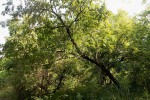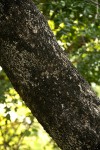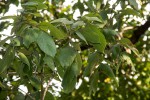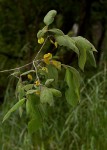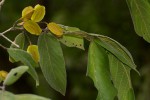Combretum molle
Selected images: Click on each image to see a larger version and details of the record View all images (22)
Detailed records: Display species records QDS maps by: Google Maps Point records by Google Maps
Species details: Click on each item to see an explanation of that item (Note: opens a new window)
| Synonyms: |
Combretum arbuscula Engl. & Diels Combretum atalanthum Diels Combretum gueinzii Sond. Combretum holosericeum Sond. Combretum splendens Engl. Combretum ulugurense Engl. & Diels |
| Common names: | Velvet bushwillow (English) |
| Frequency: | |
| Status: | Native |
| Description: |
Small to medium-sized deciduous tree. Leaves broadly elliptic, covered in grey velvety hairs on both surfaces, venation distinctly sunken above. Flowers in dense axillary spikes, greenish yellow, strongly scented. Fruit 4-winged, 1.5-2 cm in diameter, yellowish green, drying to reddish brown. |
| Type location: |
Ethiopia |
| Notes: | |
| Derivation of specific name: | molle: soft |
| Habitat: | In a wide variety of savannah and woodland habitats. It is a common constituent of Brachystegia-Julbernardia woodland. |
| Altitude range: (metres) | Up to 1750 m |
| Flowering time: | Sep - Nov |
| Worldwide distribution: | From the Arabian Peninsula, throughout Africa to northern and eastern South Africa |
| FZ divisions: | N,Z,T,MS,GI,M |
| Growth form(s): | |
| Endemic status: | |
| Red data list status: | |
| Insects associated with this species: | Hamanumida daedalus (Food plant) Thyas rubricata (Larval foodplant) |
| Spot characters: | Display spot characters for this species |
| Images last updated: | Thursday 25 June 2015 |
| Literature: |
Burrows, J.E. & Willis, C.K. (eds) (2005). Plants of the Nyika Plateau Southern African Botanical Diversity Network Report No. 31 SABONET, Pretoria Page 129. (Includes a picture). Burrows, J.E., Burrows, S.M., Lötter, M.C. & Schmidt, E. (2018). Trees and Shrubs Mozambique Publishing Print Matters (Pty), Cape Town. Page 668. (Includes a picture). Chapano, C. & Mamuto, M. (2003). Plants of the Chimanimani District National Herbarium and Botanic Garden, Zimbabwe Page 15. Chapano, C. & Mugarisanwa, N.H. (2003). Plants of the Matobo District National Herbarium and Botanic Garden, Zimbabwe Page 9. Coates Palgrave, K. et al. (1956). Trees of Central Africa National Publications Trust, Salisbury. Pages 131 - 134. (Includes a picture). Coates Palgrave, M. (1989). Guide to the trees and shrubs of the Mukuvisi Woodlands ?publisher. Page 25. Drummond, R.B. (1975). A list of trees, shrubs and woody climbers indigenous or naturalised in Rhodesia. Kirkia 10(1) Page 263. Drummond, R.B. (1981). Common Trees of the Central Watershed Woodlands of Zimbabwe. Natural Resources Board, Harare. Pages 162 - 163. (Includes a picture). Exell, A.W. (1978). Combretaceae Flora Zambesiaca 4 Pages 127 - 129. (Includes a picture). Jacobsen, W.B.G. (1967). The influence of copper content of the soil on trees and shrubs of Molly South Hill, Mangula Kirkia 6(1) Pages 63 - 84. Mapaura, A. & Timberlake, J. (eds) (2004). A checklist of Zimbabwean vascular plants Southern African Botanical Diversity Network Report No. 33 Sabonet, Pretoria and Harare Page 35. Meerts, P. & Hasson, M. (2016). Arbres et arbustes du Haut-Katanga Jardin Botanique Meise, Belgique Page 251. (Includes a picture). Ntore, S. & al. (2024). Checklist of the vascular plants of Burundi Page 83. Setshogo, M.P. (2005). Preliminary checklist of the plants of Botswana. Sabonet Report no. 37. Sabonet, Pretoria and Gaborone Page 47. Setshogo, M.P. & Venter, F. (2003). Trees of Botswana: names and distribution SABONET Report No. 18 Southern African Botanical Diversity Network, Pretoria Page 8. Siebert, S. & Mössmer, M. (Editors) (2002). SABONET Southern Mozambique Expedition 2001; Provisional Plant Checklist of the Maputo Elephant Reserve (MER) and Licuati Forest Reserve (LFR) SABONET News 7(1) Page 25. Also as Combretum gueinzii Steedman, E.C. (1933). Some Trees, Shrubs and Lianes of Southern Rhodesia. Pages 54 - 55. as Combretum holosericeum (Includes a picture). Strugnell, A.M. (2006). A Checklist of the Spermatophytes of Mount Mulanje, Malawi Scripta Botanica Belgica 34 National Botanic Garden of Belgium Page 69. |
Other sources of information about Combretum molle:
Our websites:
Flora of Botswana: Combretum molleFlora of Burundi: Combretum molle
Flora of Caprivi: Combretum molle
Flora of the DRC: Combretum molle
Flora of Malawi: Combretum molle
Flora of Zambia: Combretum molle
Flora of Zimbabwe: Combretum molle
External websites:
African Plants: A Photo Guide (Senckenberg): Combretum molleAfrican Plant Database: Combretum molle
BHL (Biodiversity Heritage Library): Combretum molle
EOL (Encyclopedia of Life): Combretum molle
GBIF (Global Biodiversity Information Facility): Combretum molle
Google: Web - Images - Scholar
iNaturalist: Combretum molle
IPNI (International Plant Names Index): Combretum molle
JSTOR Plant Science: Combretum molle
Mansfeld World Database of Agricultural and Horticultural Crops: Combretum molle
Plants of the World Online: Combretum molle
Tropicos: Combretum molle
Wikipedia: Combretum molle
